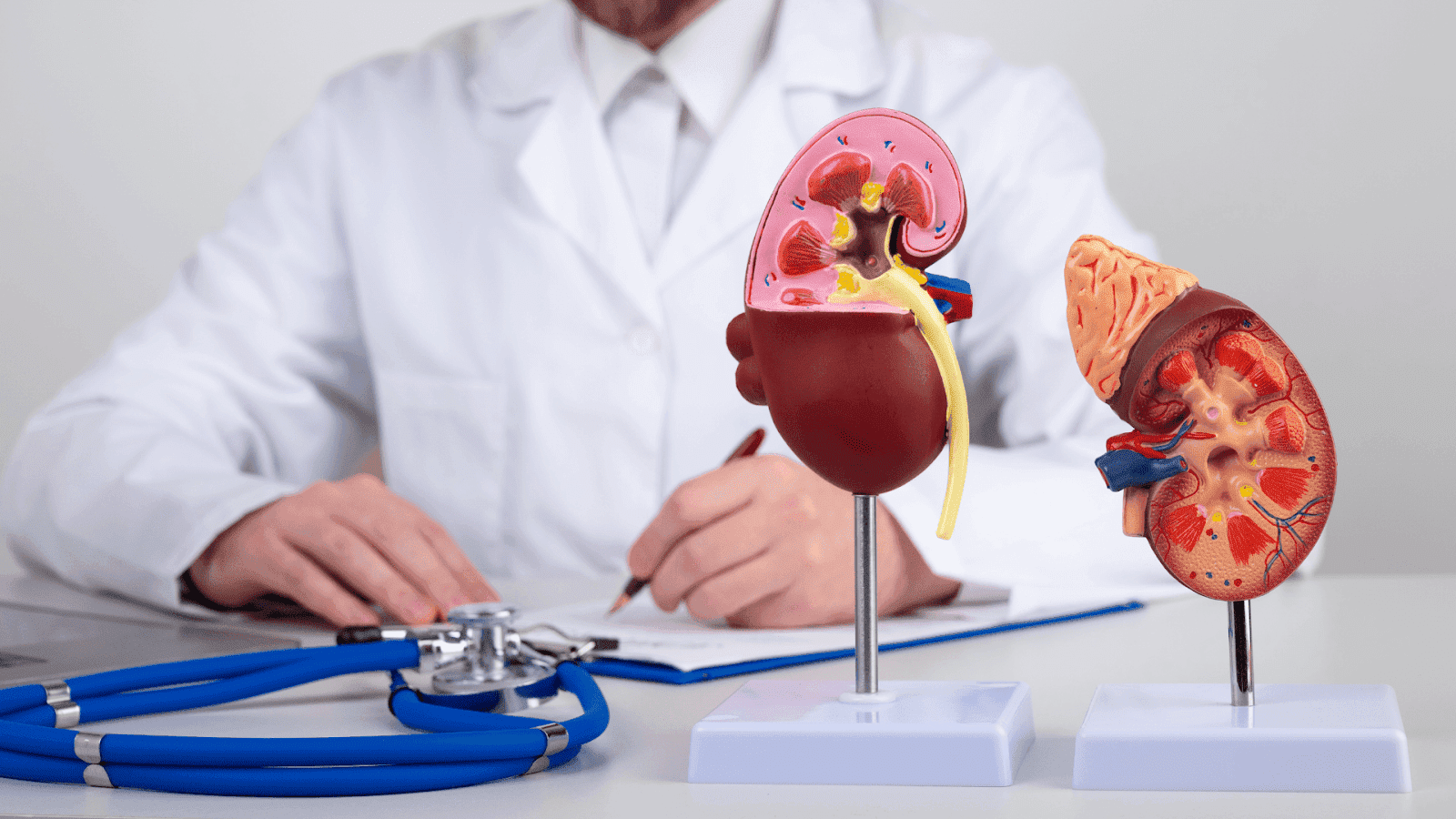Kidney Cyst Size in mm: What Is Considered Dangerous?
Kidney cysts are fluid-filled sacs that can develop in one or both kidneys. Most kidney cysts are benign and cause no symptoms, but understanding their size and potential [...]
Read More
Medically reviewed by Abhijit Bhattacharyya | MD, PhD, MBA, Tufts University School of Medicine - Miami, Florida on October 12th, 2025.
Kidney cysts are fluid-filled sacs that can develop in one or both kidneys. Most kidney cysts are benign and cause no symptoms, but understanding their size and potential risks is essential for maintaining kidney health. This article explores what kidney cyst sizes in millimeters mean, when they might be dangerous, and how modern telehealth solutions like Doctronic.ai can help you monitor and manage your kidney health conveniently.
Kidney cysts are round or oval sacs filled with fluid that form on or inside the kidneys. They are quite common, especially as people age. There are two main types of kidney cysts: simple cysts and complex cysts. Simple cysts are usually harmless and rarely cause symptoms. Complex cysts, on the other hand, may have irregular shapes, septations, or calcifications, and can sometimes be associated with kidney disease or cancer.
Simple kidney cysts often do not require treatment and are usually discovered incidentally during imaging tests for other conditions. Complex cysts, however, may need further evaluation to rule out malignancy or other complications.
While most kidney cysts are benign, their presence can sometimes indicate underlying health issues. For instance, polycystic kidney disease (PKD) is a genetic disorder characterized by the growth of numerous cysts in the kidneys, potentially leading to kidney failure over time. Patients with PKD often experience high blood pressure and may have a family history of the disease, making genetic counseling a valuable resource for those affected. Regular monitoring through imaging and blood tests is crucial for managing the condition and preventing complications.
In addition to genetic factors, lifestyle choices can also play a role in kidney health. Maintaining proper hydration, following a balanced diet low in sodium and high in fruits and vegetables, and avoiding excessive alcohol and tobacco use can help support kidney function. Furthermore, understanding the symptoms associated with kidney issues, such as flank pain, changes in urine output, or blood in the urine, can empower individuals to seek medical advice promptly. Early detection and management of kidney cysts and other related conditions can significantly improve outcomes and overall quality of life.
 Understanding Kidney Cyst Size in Millimeters
Understanding Kidney Cyst Size in MillimetersKidney cyst size is typically measured in millimeters (mm) or centimeters (cm) during ultrasound, CT scans, or MRI imaging. The size of a cyst can provide important clues about its potential impact on kidney function and overall health.
Most simple kidney cysts are small, often less than 20 mm (2 cm) in diameter. These small cysts are usually asymptomatic and do not interfere with kidney function. It is not uncommon for cysts to grow slowly over time, but many remain stable in size for years.
When cysts grow larger than 30 mm (3 cm), they may start to cause symptoms such as pain, discomfort, or pressure on surrounding organs. However, size alone is not the only factor in determining danger; the cyst’s characteristics and patient symptoms must also be considered.
Kidney cysts larger than 50 mm (5 cm) warrant closer medical attention. At this size, cysts can cause complications such as:
Compression of kidney tissue, potentially impairing function
Increased risk of cyst rupture or bleeding
Obstruction of urine flow
Potential infection within the cyst
Moreover, large cysts may cause noticeable symptoms, including flank pain, abdominal fullness, or palpable lumps. In these cases, imaging and clinical evaluation are crucial to rule out malignancy or other serious conditions.
While many kidney cysts are benign, certain features and symptoms can indicate danger or the need for intervention.
Several factors beyond size can signal potential danger:
Complex Cysts: These cysts have irregular walls, septations (internal divisions), or calcifications, which can be suggestive of malignancy.
Rapid Growth: A cyst that grows quickly over a short period may require further investigation.
Symptoms: Pain, blood in urine, high blood pressure, or urinary tract infections associated with a cyst should prompt medical evaluation.
Family History: A family history of polycystic kidney disease (PKD) or kidney cancer increases risk.
In these scenarios, imaging tests such as contrast-enhanced CT or MRI scans are often recommended to assess the cyst’s nature. Biopsy or surgical removal may be necessary if malignancy is suspected.
Polycystic kidney disease (PKD) is a genetic disorder characterized by the growth of numerous cysts in the kidneys. Unlike simple cysts, PKD cysts can cause progressive kidney damage, leading to chronic kidney disease or kidney failure. In PKD, cyst size and number both contribute to disease severity.
If you have multiple cysts or a family history of PKD, regular monitoring and consultation with a healthcare provider are essential. Early detection and management can help slow disease progression.
Monitoring kidney cysts involves regular imaging and symptom tracking. Here are key steps to keep kidney cysts under control:
Ultrasound is often the first imaging modality used to detect and measure kidney cysts. It is non-invasive, cost-effective, and does not expose patients to radiation. For a more detailed evaluation, CT scans or MRIs may be ordered, especially if cysts are large or complex.
Pay attention to any new symptoms such as pain in the side or back, blood in the urine, swelling, or changes in urination. These may indicate cyst complications or other kidney issues.
Regular check-ups with a healthcare provider are critical to interpreting imaging results and deciding on treatment plans. For those seeking convenient and affordable access to medical advice, telehealth platforms like Doctronic.ai offer video visits with licensed doctors 24/7 across all 50 states. This service allows patients to discuss symptoms, get second opinions, and receive treatment recommendations without leaving home.
Most simple kidney cysts do not require treatment unless they cause symptoms or complications. When intervention is necessary, several options exist:
For symptomatic cysts, aspiration and sclerotherapy can be performed. This involves draining the cyst fluid and injecting a solution to prevent recurrence. This procedure is usually done under imaging guidance and offers relief from pain or pressure.
In cases where cysts are very large, complex, or suspicious for cancer, surgical removal may be recommended. Minimally invasive laparoscopic surgery is often preferred to reduce recovery time.
If kidney cysts are part of a broader condition like PKD, managing blood pressure, avoiding nephrotoxic substances, and regular monitoring are essential. Your healthcare provider can guide you through lifestyle changes and medications to preserve kidney function.
Doctronic.ai is revolutionizing healthcare by providing AI-powered, direct-to-patient medical care that is fast, smart, and personal. With over 10 million users, it offers free AI doctor visits that synthesize the latest peer-reviewed medical research to answer your questions and provide treatment recommendations in seconds.
When it comes to kidney cysts, Doctronic.ai can help you understand your imaging results, interpret symptoms, and decide when to seek in-person care. If needed, you can also book affordable telehealth video visits with licensed doctors available 24/7 nationwide for less than $40. This convenience ensures timely medical advice without the hassle of traditional appointments.
Visit Doctronic.ai today to experience the future of primary care powered by AI, and get personalized kidney health support whenever you need it.
 Monitoring, Managing, and Maintaining Healthy Kidneys
Monitoring, Managing, and Maintaining Healthy KidneysKidney cyst size in millimeters is an essential factor in assessing risk, but it is not the only consideration. Simple cysts under 30 mm are generally harmless, while cysts larger than 50 mm or those with complex features require careful evaluation. Symptoms, cyst characteristics, and family history also play crucial roles in determining danger.
Regular monitoring through imaging and symptom awareness is key to managing kidney cysts effectively. Telehealth services like Doctronic.ai offer accessible, expert guidance to help you navigate kidney health concerns with confidence and convenience.
Remember, if you notice any unusual symptoms or have questions about your kidney cysts, don’t hesitate to seek medical advice promptly. Early detection and intervention can make all the difference in maintaining healthy kidneys.
Don't wait for symptoms to worsen or for uncertainty to grow. With Doctronic, you can get immediate, AI-powered medical insights into your kidney cyst concerns. Our AI doctor is ready to provide you with a personalized, comprehensive understanding of your condition, drawing from the most current, peer-reviewed medical research. Experience the most modern, personal, and convenient healthcare available. Skip the line and talk to an AI Doctor now, for free, and take the first step towards peace of mind and proactive kidney care.
Kidney cysts are fluid-filled sacs that can develop in one or both kidneys. Most kidney cysts are benign and cause no symptoms, but understanding their size and potential [...]
Read More